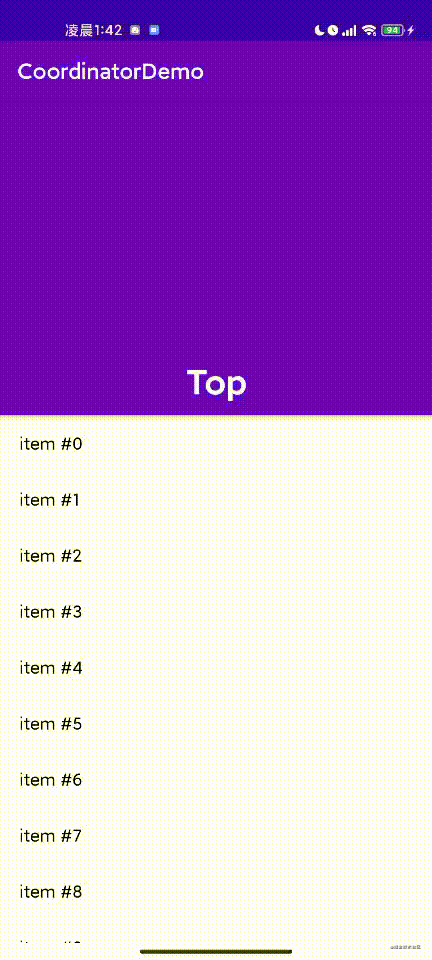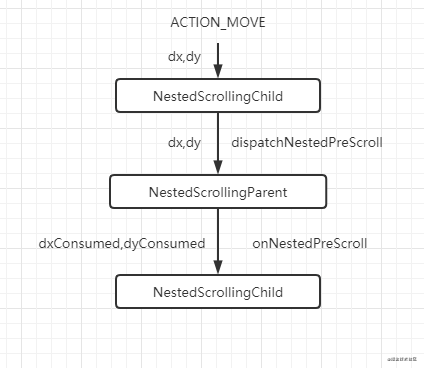Android 嵌套滑动总结,android 项目驱动式开发教程
xmlns:app="http://schemas.android.com/apk/res-auto"
xmlns:tools="http://schemas.android.com/tools"
android:layout_width="match_parent"
android:layout_height="match_parent">
<com.google.android.material.appbar.AppBarLayout
android:layout_height="300dp"
android:layout_width="match_parent">
// 可滑动部分
<View
android:layout_width="match_parent"
android:layout_height="0dp"
android:layout_weight="1"
app:layout_scrollFlags="scroll"/>
<TextView
android:layout_width="match_parent"
android:layout_height="64dp"
android:layout_gravity="bottom"
android:text="Top"
android:textSize="32sp"
android:textColor="@color/white"
android:gravity="center"
android:textStyle="bold"/>
</com.google.android.material.appbar.AppBarLayout>
<androidx.recyclerview.widget.RecyclerView
android:id="@+id/rv"
android:layout_width="match_parent"
android:layout_height="wrap_content"
app:layout_behavior="@string/appbar_scrolling_view_behavior"/>
</androidx.coordinatorlayout.widget.CoordinatorLayout>
将 AppBarLayout 中需要上滑隐藏的部分的 scrollFlag 指定为 scroll ,在 RecyclerView 中指定 behavior 为 appbar_scrolling_view_behavior 就可以实现最简单的吸顶嵌套滑动,如下:

看起来像带有 header 的 RecyclerView 在滑动,但其实是嵌套滑动。
layout_scrollFlags 和 layout_behavior 有很多可选值,配合起来可以实现多种效果,不只限于嵌套滑动。具体可以参考 API 文档。
使用 CoordinatorLayout 实现嵌套滑动比手动实现要好得多,既可以实现连贯的吸顶嵌套滑动,又支持 fling。而且是官方提供的布局,可以放心使用,出 bug 的几率很小,性能也不会有问题。不过也正是因为官方将其封装得很好,使用 CoordinatorLayout 很难实现比较复杂的嵌套滑动布局,比如多级嵌套滑动。
[](
)3、嵌套滑动组件 NestedScrollingParent 和 NestedScrollingChild
NestedScrollingParent 和 NestedScrollingChild 是 google 官方提供地一套专门用来解决嵌套滑动地组件。它们是两个接口,代码如下:
public interface NestedScrollingParent2 extends NestedScrollingParent {
boolean onStartNestedScroll(@NonNull View child, @NonNull View target, @ScrollAxis int axes,
@NestedScrollType int type);
void onNestedScrollAccepted(@NonNull View child, @NonNull View target, @ScrollAxis int axes,
@NestedScrollType int type);
void onStopNestedScroll(@NonNull View target, @NestedScrollType int type);
void onNestedScroll(@NonNull View target, int dxConsumed, int dyConsumed,
int dxUnconsumed, int dyUnconsumed, @NestedScrollType int type);
void onNestedPreScroll(@NonNull View target, int dx, int dy, @NonNull int[] consumed,
@NestedScrollType int type);
}
public interface NestedScrollingChild2 extends NestedScrollingChild {
boolean startNestedScroll(@ScrollAxis int axes, @NestedScrollType int type);
void stopNestedScroll(@NestedScrollType int type);
boolean hasNestedScrollingParent(@NestedScrollType int type);
boolean dispatchNestedScroll(int dxConsumed, int dyConsumed,
int dxUnconsumed, int dyUnconsumed, @Nullable int[] offsetInWindow,
@NestedScrollType int type);
boolean dispatchNestedPreScroll(int dx, int dy, @Nullable int[] consumed,
@Nullable int[] offsetInWindow, @NestedScrollType int type);
}
需要嵌套滑动的 View 可以实现这两个接口,复写其中的方法。这套组件实现嵌套滑动的核心原理很简单,主要是以下三步:
NestedScrollingChild在onTouchEvent方法中先将ACITON_MOVE事件产生的位移 dx 和 dy 通过dispatchNestedPreScroll传递给NestedScrollingParentNestedScrollingParent在onNestedPreScroll中接受到 dx 和 dy 并进行消费。并将消费掉的位移放入int[] consumed中,consumed数组是一个长度为 2 的 int 类型数组,consumed[0]代表 x 轴的消耗,consumed[1]代表 y 轴的消耗NestedScrollingChild之后从int[] consumed数组中拿到NestedScrollingParent已经消费掉的位移,减去之后得到剩余的位移,再由自己消费
滑动位移传递方向由 child -> parent -> child,如下图。如果 child 是 Recyclerview ,它会先把位移给父布局消费,这时父布局滑动。当父布局滑动顶到不能滑动时,Recyclerview 这时会消费全部位移,这时它自己开始滑动,这样就形成了嵌套滑动,效果正如之前的例子中所看到的。

dispatchNestedScroll 和 onNestedScroll 的作用原理上述 preScroll 的方法类似,只不过这两个方法构造的嵌套滑动顺序和 preScroll 的相反,是子 View 先消费,子 View 消费不了的时候,再由父 View 再消费。
这套机制还支持 fling,在手指离开 view 的时候,即产生 ACITON_UP 事件时,child 将此时的 Velocity 转化为位移 dx 或 dy,并重复之前的流程。通过 @NestedScrollType int type 的值来判断是 TYPE_TOUCH 还是 TYPE_NON_TOUCH, TYPE_TOUCH 就是滑动, TYPE_NON_TOUCH 就是 fling。
[](
)Android 中哪些 View 使用了这套滑动机制?
实现
NestedScrollingParent接口的 View 有:NestedScrollView、CoordinatorLayout、MotionLayout等实现
NestedScrollingChild接口的 View 有:NestedScrollView、RecyclerView等NestedScrollView是唯一同时实现两个接口的 View,这意味着它可以用作中介来实现多级嵌套滑动,后面会说到。
从上面可以看到,实际上,之前提到的 CoordinatorLayout 实现的嵌套滑动,本质上也是通过这套 NestedScrolling 接口来实现的。但是由于它封装得太好,我们没办法做过多定制。而直接使用这套接口,就可以根据自己的需求做定制。
大部分的场景中,我们不需要去实现 NestedScrollingChild 接口,因为 RecyclerView 已经做了这个实现,而涉及到嵌套滑动场景的子 View 基本也都是 RecyclerView。我们看看 RecyclerView 的相关源码:
public boolean onTouchEvent(MotionEvent e) {
...
case MotionEvent.ACTION_MOVE: {
...
// 计算 dx,dy
int dx = mLastTouchX - x;
int dy = mLastTouchY - y;
...
mReusableIntPair[0] = 0;
mReusableIntPair[1] = 0;
...
// 分发 preScroll
if (dispatchNestedPreScroll(
canScrollHorizontally ? dx : 0,
canScrollVertically ? dy : 0,
mReusableIntPair, mScrollOffset, TYPE_TOUCH
)) {
// 减去父 view 消费掉的位移
dx -= mReusableIntPair[0];
dy -= mReusableIntPair[1];
mNestedOffsets[0] += mScrollOffset[0];
mNestedOffsets[1] += mScrollOffset[1];
getParent().requestDisallowInterceptTouchEvent(true);
}
...
} break;
...
}
boolean scrollByInternal(int x, int y, MotionEvent ev) {
int unconsumedX = 0;
int unconsumedY = 0;
int consumedX = 0;
int consumedY = 0;
if (mAdapter != null) {
mReusableIntPair[0] = 0;
mReusableIntPair[1] = 0;
// 先消耗掉自己的 scroll
scrollStep(x, y, mReusableIntPair);
consumedX = mReusableIntPair[0];
consumedY = mReusableIntPair[1];
// 计算剩余的量
unconsumedX = x - consumedX;
unconsumedY = y - consumedY;
}
mReusableIntPair[0] = 0;
mReusableIntPair[1] = 0;
// 分发 nestedScroll 给父 View,顺序和 preScroll 刚好相反
dispatchNestedScroll(consumedX, consumedY, unconsumedX, unconsumedY, mScrollOffset,
TYPE_TOUCH, mReusableIntPair);
unconsumedX -= mReusableIntPair[0];
unconsumedY -= mReusableIntPair[1];
...
}
RecyclerView 是怎么调到父 View 的 onNestedPreSroll 和 onNestedScroll 的呢?分析一下 dispatchNestedPreScroll 的代码,如下,dispatchNestedScroll 的代码原理和此类似,不再贴出:
public boolean dispatchNestedPre
Scroll(int dx, int dy, int[] consumed, int[] offsetInWindow,
int type) {
return getScrollingChildHelper().dispatchNestedPreScroll(dx, dy, consumed, offsetInWindow,type);
}
// NestedScrollingChildHelper.java
public boolean dispatchNestedPreScroll(int dx, int dy, @Nullable int[] consumed,
@Nullable int[] offsetInWindow, @NestedScrollType int type) {
if (isNestedScrollingEnabled()) {
final ViewParent parent = getNestedScrollingParentForType(type);
if (parent == null) {
return false;
}
if (dx != 0 || dy != 0) {
...
consumed[0] = 0;
consumed[1] = 0;
ViewParentCompat.onNestedPreScroll(parent, mView, dx, dy, consumed, type);
...
}
...
}
return false;
}
// ViewCompat.java
public static void onNestedPreScroll(ViewParent parent, View target, int dx, int dy,
int[] consumed, int type) {
if (parent instanceof NestedScrollingParent2) {
// First try the NestedScrollingParent2 API
((NestedScrollingParent2) parent).onNestedPreScroll(target, dx, dy, consumed, type);
} else if (type == ViewCompat.TYPE_TOUCH) {
// Else if the type is the default (touch), try the NestedScrollingParent API
if (Build.VERSION.SDK_INT >= 21) {
try {
parent.onNestedPreScroll(target, dx, dy, consumed);
} catch (AbstractMethodError e) {
Log.e(TAG, "ViewParent " + parent + " does not implement interface "
"method onNestedPreScroll", e);
}
} else if (parent instanceof NestedScrollingParent) {
((NestedScrollingParent) parent).onNestedPreScroll(target, dx, dy, consumed);
}
}
}
可以看到,RecyclerView 通过一个代理类 NestedScrollingChildHelper 完成滑动分发,最后交给 ViewCompat 的静态方法来让父 View 处理 onNestedPreScroll。ViewCompat 的主要作用是用来兼容不同版本的滑动接口。
[](
)实现 onNestedPreScroll 方法
从上面的代码可以清楚地看到 RecyclerView 对于 NestedScrollingChild 的实现,以及触发嵌套滑动的时机。如果我们要实现嵌套滑动,并且内部的滑动子 View 是 RecyclerView,那么只需要让外层的父 View 实现 NestedScrollingParent 的方法就行了,比如在 onNestedPreScroll 方法中,
@Override
public void onNestedPreScroll(@NonNull View target, int dx, int dy, @NonNull int[] consumed, int type) {
// 滑动 dy 距离
scrollBy(0, dy);
// 将消耗掉的 dy 放入 consumed 数组通知子 view
consumed[1] = dy;
}
这样就实现了最简单的嵌套滑动。当然,实际情况中,还要对滑动距离进行判断,不能让父 View 一直消费子 View 的位移。
[](
)关于 NestedScrollView
像 NestedScrollView 这样的类,由于它内部实现了 onNestedScroll,所以在下滑时,它能在内部的 RecyclerView 下滑直到列表顶端时,外层继续下滑而不用抬起手指。另外也实现了 onNestedPreScroll方法,只不过它在该方法中把滑动继续向上传递,自己没有消费,如下代码:
// NestedScrollView.java
public void onNestedPreScroll(@NonNull View target, int dx, int dy, @NonNull int[] consumed,
int type) {
// 只分发了 preScroll 自己并没有消费。之所以能分发是因为 NestedScrollView 同时实现了 NestedScrollingChild 接口
dispatchNestedPreScroll(dx, dy, consumed, null, type);
}
@Override
public boolean dispatchNestedPreScroll(int dx, int dy, int[] consumed, int[] offsetInWindow,
int type) {
return mChildHelper.dispatchNestedPreScroll(dx, dy, consumed, offsetInWindow, type);
}
// NestedScrollingChildHelper.java
public boolean dispatchNestedPreScroll(int dx, int dy, @Nullable int[] consumed,
@Nullable int[] offsetInWindow, @NestedScrollType int type) {
if (isNestedScrollingEnabled()) {
final ViewParent parent = getNestedScrollingParentForType(type);
if (parent == null) {
return false;
}
if (dx != 0 || dy != 0) {
...
consumed[0] = 0;
consumed[1] = 0;
ViewParentCompat.onNestedPreScroll(parent, mView, dx, dy, consumed, type);












评论